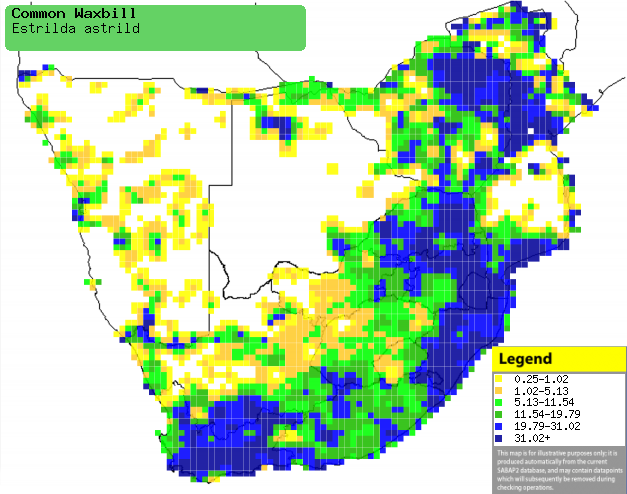|
Estrilda astrild (Common
waxbill)
Rooibeksysie [Afrikaans]; Intshiyane
[Xhosa]; iNtiyane [Zulu]; Katjikilili (applied to some of waxbills and
twinspots) [Kwangali]; Borahane, Borane (also aplied to other waxbills and
firefinches) [South Sotho]; Xindzingiri bhanga (also applied to Violet-eared
waxbill and Green-winged pytilia) [Tsonga]; Sint-helenafazantje [Dutch]; Astrild
ondulé [French]; Wellenastrild [German]; Bico-de-lacre-comum [Portuguese]
Life
> Eukaryotes >
Opisthokonta
> Metazoa (animals) >
Bilateria >
Deuterostomia > Chordata >
Craniata > Vertebrata (vertebrates) > Gnathostomata (jawed
vertebrates) > Teleostomi (teleost fish) > Osteichthyes (bony fish) > Class:
Sarcopterygii (lobe-finned
fish) > Stegocephalia (terrestrial
vertebrates) > Tetrapoda
(four-legged vertebrates) > Reptiliomorpha > Amniota >
Reptilia (reptiles) >
Romeriida > Diapsida > Archosauromorpha > Archosauria >
Dinosauria
(dinosaurs) > Saurischia > Theropoda (bipedal predatory dinosaurs) >
Coelurosauria > Maniraptora >Aves
(birds) > Order: Passeriformes
> Family: Estrildidae
Distribution and habitat
Occurs across much of sub-Saharan Africa, from Guinea to
Ethiopia south to southern Africa. Here it is most common in Mozambique,
Zimbabwe, northern Botswana and South Africa, with more localised populations in
Namibia. It generally prefers rank vegetation in moist grassland, fynbos and
savanna, also occupying moist natural growth bordering on cultivated land and
tangled vegetation along rivers and streams.
|
 |
|
Distribution of Common waxbill in southern Africa,
based on statistical smoothing of the records from first SA Bird Atlas
Project (©
Animal Demography unit, University of
Cape Town; smoothing by Birgit Erni and Francesca Little). Colours range
from dark blue (most common) through to yellow (least common).
See here for the latest distribution
from the SABAP2. |
Predators
It (at different stages of development) has been recorded
as prey of the following animals:
- adults
- Lanius collaris (Common fiscal)
- Possibly
mantids, as a large individual was found feeding on a still warm
waxbill.
- young
- Lamprophis fuliginosus (Brown house snake)
Food
It does most of its foraging in flocks of around 30 or more
birds, feeding on the seeds and flowers of grasses, supplemented with fruit and
insects. The following food items have been recorded in its
diet:
- Plants
- seeds and flowers
- Melinis repens (Natal redtop)
- Panicum maximum (Guinea grass)
- Panicum laevifolium
- Paspalum
- Pennisetum macrourum (Bedding grass)
- Setaria verticillata (Bur bristle grass)
- Tricholaena monachne (Blousaadgras)
- Urochloa mosambicensis (Gonya grass)
- seeds
- sedges
- Verbena bonariensis (verbena)
- Casuarina (beefwood)
- fruit of Ficus sycomorus (Sycomore fig)
- Small insects
Breeding
- The nest is built the male, consisting of a horizontal pear-shaped
structure with a tubular entrance tunnel, made of stems and inflorescences
of green grass, while the egg chamber is lined by the female with fine grass
and feathers. Additionally a partially enclosed cup may built on top of the
main structure, possibly to confuse predators. It is typically placed on the
ground, with the entrance overlooking a small patch of bare soil, although
it may conceal it in thick vegetation about 1-3 metres above ground instead.
- Egg-laying season is year round, peaking from September-October in the
Western Cape, but from November-May peaking from December-February
elsewhere.
- It lays 3-9, usually 4-6 eggs, which are incubate by both sexes for
about 11-12 days.
- The chicks are fed and brooded by both parents, leaving the nest after
about 17-21 days, after which they return the nest to roost for a few more
days.
Threats
Not threatened.
References
-
Hockey PAR, Dean WRJ and Ryan PG 2005. Roberts - Birds of
southern Africa, VIIth ed. The Trustees of the John Voelcker Bird Book
Fund, Cape Town.
|
